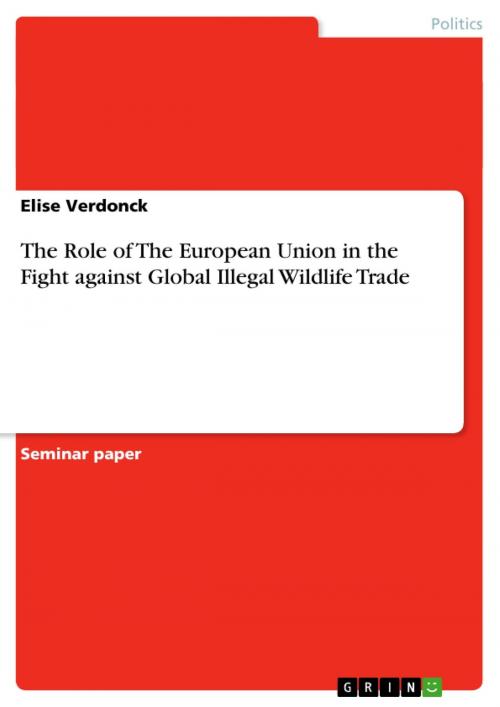The Role of The European Union in the Fight against Global Illegal Wildlife Trade
Nonfiction, Social & Cultural Studies, Political Science, International, International Relations| Author: | Elise Verdonck | ISBN: | 9783656842828 |
| Publisher: | GRIN Verlag | Publication: | November 20, 2014 |
| Imprint: | GRIN Verlag | Language: | English |
| Author: | Elise Verdonck |
| ISBN: | 9783656842828 |
| Publisher: | GRIN Verlag |
| Publication: | November 20, 2014 |
| Imprint: | GRIN Verlag |
| Language: | English |
Seminar paper from the year 2014 in the subject Politics - Basics and General, grade: A, University of Auckland, course: European Environmental Law & Governance, language: English, abstract: The European Union (EU) ranks at the top of the list of global importers of wild animal and plant products. The estimated declared import value of the legal trade in wildlife products is worth billions of euros a year, and the extent of the EU market for wildlife products increases annually. The demand for wildlife animals and products is escalating worldwide. The majority of the wildlife trade into and within the EU is being exercised within the boundaries of the law, however illegal wildlife trade still occurs. Every year the enforcement authorities in the EU make over 5000 seizures. This illegal trafficking does not take into account sustainability concerns and may therefore result in the extinction of a species. Factors such as very high prices for wildlife products on the black market, low political awareness and low penalties aggravate the unsustainable and illegal trade. At the level of the EU many significant achievements in combating illegal wildlife trafficking have been accomplished. The biggest example of that are the EU Wildlife Trade Regulations, which implement the obligations for its member states under the Convention on International Trade in Endangered Species of Wild Fauna and Flora (CITES). More in-depth national, regional and international cooperation could even enhance the current initiatives in this context. The European Commission is currently working on a plan of action against illegal wildlife trade. This plan is the result of the Resolution on Wildlife Crime that was filed in 2014 by the European Parliament. This action plan will considerably strengthen the EU's response to illegal trade. Another key issue that needs to be dealt with is the sustainability of the global trade in wildlife. The controlling mechanisms implemented by CITES, that have been introduced worldwide, will always have their weaknesses. No permit system will guarantee that illegal wildlife trade will be banned. Criminal organisations always find the weak links in the systems and use them to plan their transits from one country to the other. Political initiatives to cease illegal wildlife trade will only be effective on the long term, if also the demand in the consuming countries will be tackled. The EU can play a huge role in the global wildlife trade by using its legislative powers to endorse particular objectives outside its territorial borders, such as reducing the demand in major consuming countries.
Seminar paper from the year 2014 in the subject Politics - Basics and General, grade: A, University of Auckland, course: European Environmental Law & Governance, language: English, abstract: The European Union (EU) ranks at the top of the list of global importers of wild animal and plant products. The estimated declared import value of the legal trade in wildlife products is worth billions of euros a year, and the extent of the EU market for wildlife products increases annually. The demand for wildlife animals and products is escalating worldwide. The majority of the wildlife trade into and within the EU is being exercised within the boundaries of the law, however illegal wildlife trade still occurs. Every year the enforcement authorities in the EU make over 5000 seizures. This illegal trafficking does not take into account sustainability concerns and may therefore result in the extinction of a species. Factors such as very high prices for wildlife products on the black market, low political awareness and low penalties aggravate the unsustainable and illegal trade. At the level of the EU many significant achievements in combating illegal wildlife trafficking have been accomplished. The biggest example of that are the EU Wildlife Trade Regulations, which implement the obligations for its member states under the Convention on International Trade in Endangered Species of Wild Fauna and Flora (CITES). More in-depth national, regional and international cooperation could even enhance the current initiatives in this context. The European Commission is currently working on a plan of action against illegal wildlife trade. This plan is the result of the Resolution on Wildlife Crime that was filed in 2014 by the European Parliament. This action plan will considerably strengthen the EU's response to illegal trade. Another key issue that needs to be dealt with is the sustainability of the global trade in wildlife. The controlling mechanisms implemented by CITES, that have been introduced worldwide, will always have their weaknesses. No permit system will guarantee that illegal wildlife trade will be banned. Criminal organisations always find the weak links in the systems and use them to plan their transits from one country to the other. Political initiatives to cease illegal wildlife trade will only be effective on the long term, if also the demand in the consuming countries will be tackled. The EU can play a huge role in the global wildlife trade by using its legislative powers to endorse particular objectives outside its territorial borders, such as reducing the demand in major consuming countries.















